Key takeaways:
- Street photography captures the essence of everyday life and emphasizes the importance of connecting with strangers to uncover their stories.
- Effective techniques for approaching individuals include using open body language, starting conversations with questions, and respecting their comfort levels.
- Candid moments, where subjects are unaware of the photographer, often convey deeper emotional narratives and authenticity.
- Creating a personal photography gallery can reflect the photographer’s journey and enhance the storytelling aspect through emotional connections and accompanying notes.

Understanding Street Photography
Street photography embodies more than just snapping photos of strangers; it invites one to capture the essence of everyday life in its rawest form. I remember the thrill of approaching a street musician, my camera poised to freeze the moment. The look in his eyes, a blend of hope and resignation, told a story that words could never express—how often do we miss these fleeting narratives around us?
As I wander city streets, each encounter feels like a dance between the photographer and the subject. I often wonder, how can I best honor their story through my lens? This question fuels my passion, leading me to seek connections with my subjects rather than seeing them merely as objects to photograph.
The beauty of street photography lies in its unpredictability. I find that capturing spontaneous moments often leads to the most compelling images. One time, I snapped a candid shot of a child laughing with abandon, and that moment of joy became a cherished memory. Don’t you find that these unplanned interactions not only enhance our photography but also enrich our understanding of the human experience?
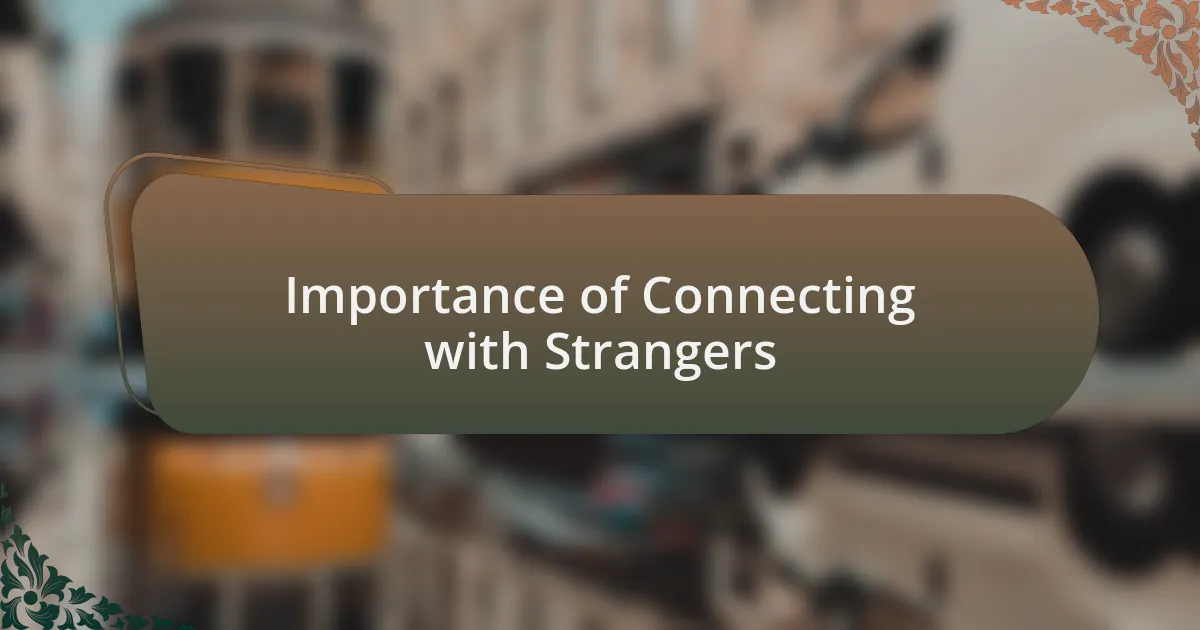
Importance of Connecting with Strangers
Connecting with strangers is at the heart of street photography, and it opens doors to stories and emotions that can elevate our work. I recall a day when I struck up a conversation with an elderly woman selling handmade crafts. As she shared the tales behind each piece, I realized that these interactions not only enriched my photographs but also gave me a deeper appreciation for the lives unfolding around me. Isn’t it fascinating how a simple exchange can transform a photo into a narrative brimming with context?
Establishing a rapport with strangers makes each photograph a collaboration, a shared moment of vulnerability. I once approached a group of friends laughing animatedly in a park. I asked if I could capture their joy, and they eagerly agreed, inviting me into their world for a fleeting time. That candid photo became a testament to their friendship, reminding me that human connections can be powerful catalysts for artistic inspiration.
In our increasingly fragmented world, these fleeting bonds serve as a reminder of our shared humanity. I often think about how easy it is to feel disconnected as we rush through our busy lives. Every time I connect with a stranger, I find a piece of myself reflected back. Wouldn’t it be wonderful if we all took a moment to engage with those around us? Each conversation has the potential to transform not only our art but also our perspective on life itself.
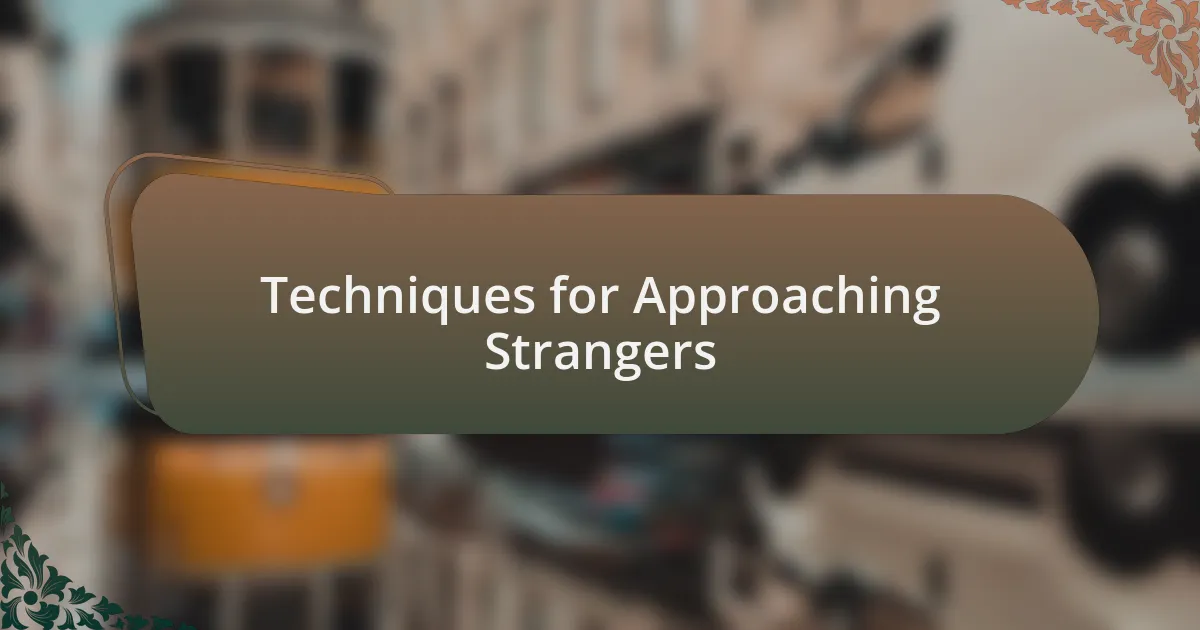
Techniques for Approaching Strangers
When it comes to approaching strangers, I find that body language plays a crucial role. I always try to approach with an open stance and a warm smile—it signals to the person that my intention is friendly. Once, I saw a young artist sketching in a bustling square. Instead of interrupting her concentration, I softly complimented her work from a distance, which broke the ice and led to a delightful conversation about her creative process.
Another effective technique is to start with a question or an observation. I remember walking through a street market when I spotted a vendor with colorful spices. I simply asked about her favorite spice and, before I knew it, we were chatting about her family’s recipes. That one question opened the door to learning about her culture, allowing me to capture not just her image but an aspect of her story that infused my photograph with meaning.
Finally, gauging the stranger’s comfort level is essential. If someone seems preoccupied or uninterested, it’s important to respect that space. I once approached a man sitting alone on a bench. After a brief exchange, he politely declined my request to take his portrait. I appreciated his honesty while understanding that not every attempt results in a connection. Isn’t it intriguing how balance between assertiveness and sensitivity can affect our interactions?
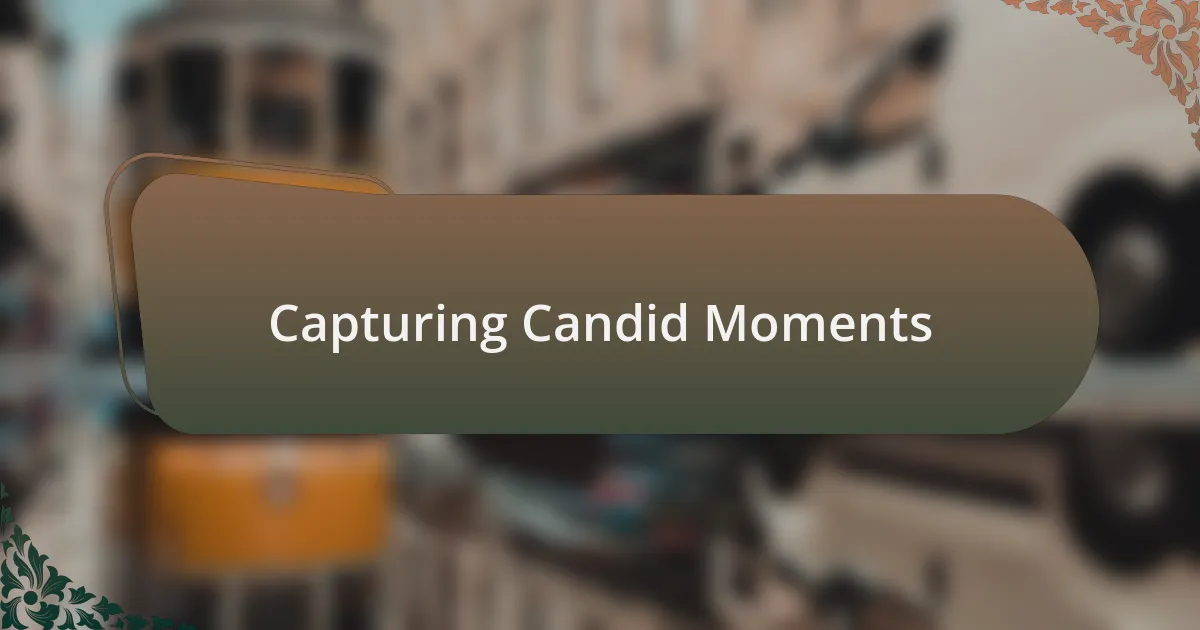
Capturing Candid Moments
When I think of capturing candid moments, I often remember a rainy afternoon in a busy park. I spotted a father twirling his daughter around, her laughter echoing against the backdrop of gray skies. I instinctively reached for my camera, crouching low to get a child’s-eye view of their playful dance. That image, filled with joy and spontaneity, perfectly conveyed the connection they shared in a fleeting moment.
There’s something magical about capturing people when they’re unaware of the camera. On a recent trip to the city, I saw a group of friends deep in conversation, animated and full of life. Instead of disrupting their flow, I blended into the background, allowing the scene to unfold naturally. Later, when I reviewed the photos, I found that those unguarded expressions told stories far richer than posed shots ever could. How do we translate that authenticity into our work? It starts with patience and an unwavering curiosity, qualities that I believe every photographer should nurture.
Occasionally, I find that the most impactful candid moments arise from the simplest interactions. I once observed a woman helping an elderly man navigate a busy street, their connection palpable despite the surrounding chaos. The kindness they shared sparked a feeling within me, urging me to capture that genuine encounter. In those brief, shared moments, I realized that photography is not just about images; it’s about preserving the essence of humanity. How often do we overlook these treasures in our fast-paced lives?
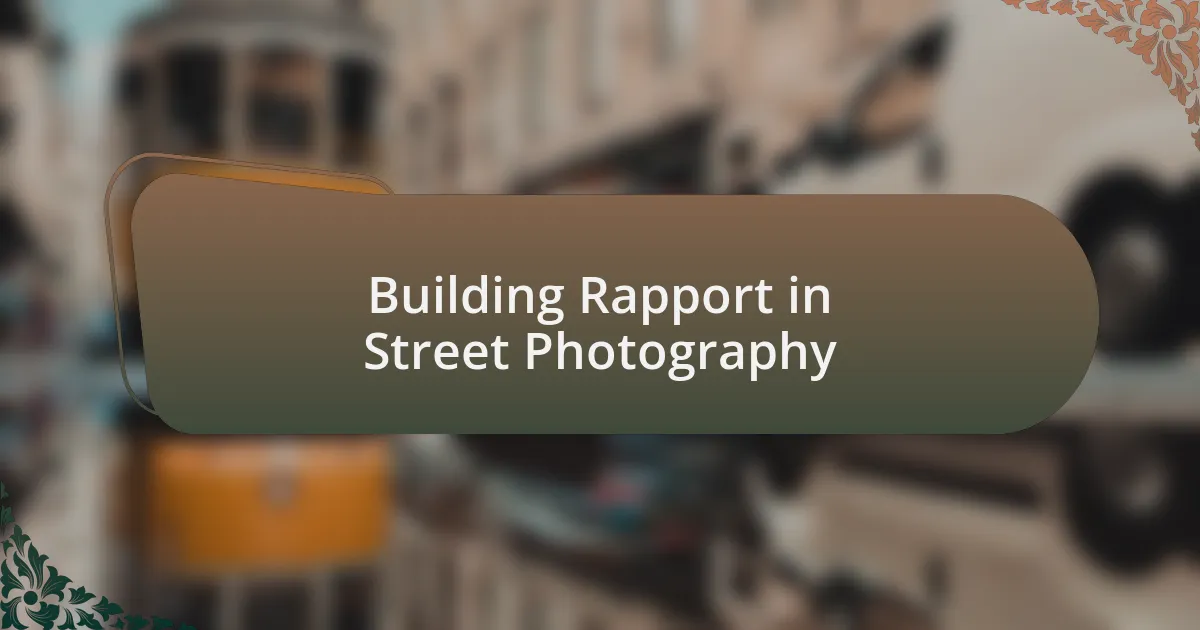
Building Rapport in Street Photography
Building rapport in street photography is an art in itself. I remember standing on a bustling street corner, my camera in hand, when I noticed a group of dancers practicing their routine. Instead of merely shooting from a distance, I approached them with a smile and complimented their skills. This small interaction transformed the atmosphere; they became more animated and open, allowing me to capture vibrant photos that radiated joy and energy. Isn’t it fascinating how a genuine connection can enhance the visual story?
As I continued my journey through the city, I made it a point to engage with people before snapping their pictures. Once, during a street festival, I struck up a conversation with a vendor selling handmade jewelry. By sharing my appreciation for their craft, I felt a bond forming. When I finally clicked the shutter, it felt like I was documenting not just their work, but also our shared exchange of stories and passion. Doesn’t this approach enrich your photography experience?
Incorporating small gestures, like a nod or brief eye contact, can significantly deepen connections while photographing strangers. I vividly recall a moment with an elderly man sitting on a park bench. I took a brief pause and simply smiled at him. That moment of acknowledgment opened up a dialogue, and I learned about his life. The portrait I took afterward was infused with a depth that I believe stemmed from our rapport. How powerful it is to think that a simple smile can lead to such meaningful interactions and stunning imagery!
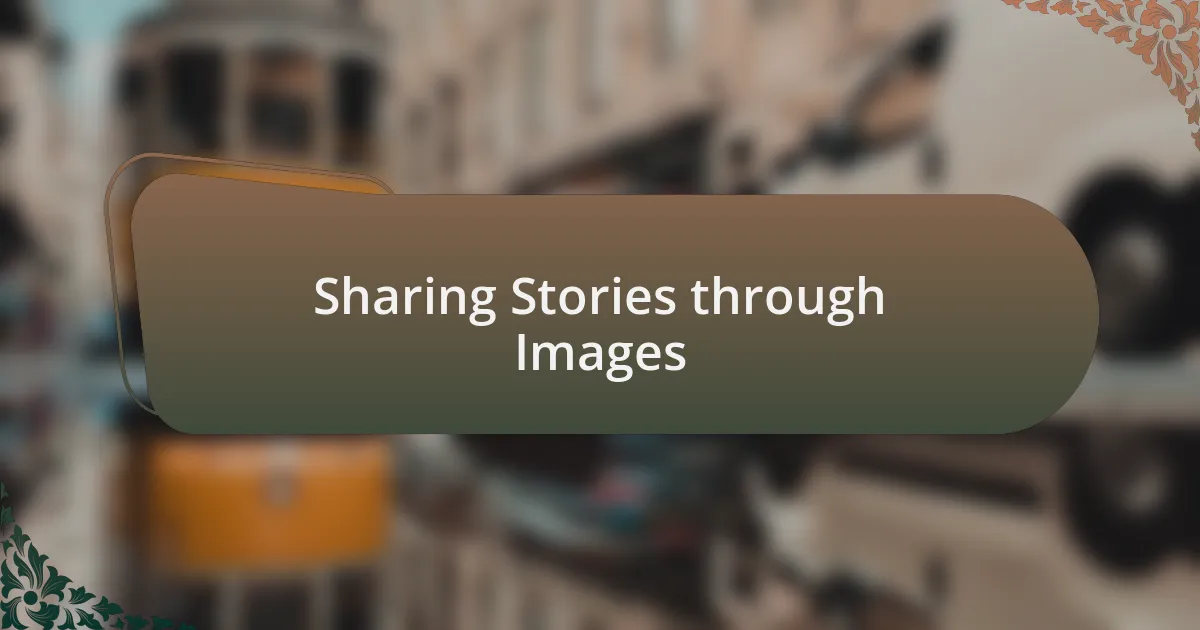
Sharing Stories through Images
Images have a remarkable ability to convey stories that words sometimes cannot. I remember capturing a candid moment of a young girl laughing with her friends in the park. The joy on her face told a story of innocence and carefree days that resonated deeply with me. When I later shared that photo, others felt that same happiness, sparking conversations about their own childhood memories. Isn’t it amazing how a single image can evoke such shared human experiences?
Every photograph I take is a chapter in a larger narrative. There was this one time I stumbled upon a street artist painting a mural, surrounded by people watching in awe. After chatting with him about his inspiration, I snapped a shot that didn’t just capture his art but also the energy of the crowd. That image was alive with emotions, showing not just his talent, but the connection he formed with those around him. How often do we neglect the stories behind the subjects we photograph?
In the hustle and bustle of urban life, I often find that slowing down and engaging with my environment significantly enhances the stories I capture. One evening, as twilight painted the sky, I approached a musician playing soulful tunes on the sidewalk. We talked about his journey and dreams, and when I took his portrait, it felt like I was not only documenting a moment but encapsulating his hopes and struggles. Have you ever felt that rush of capturing something deeper than just a visual? It’s those moments that remind me why storytelling through images is so profoundly impactful.
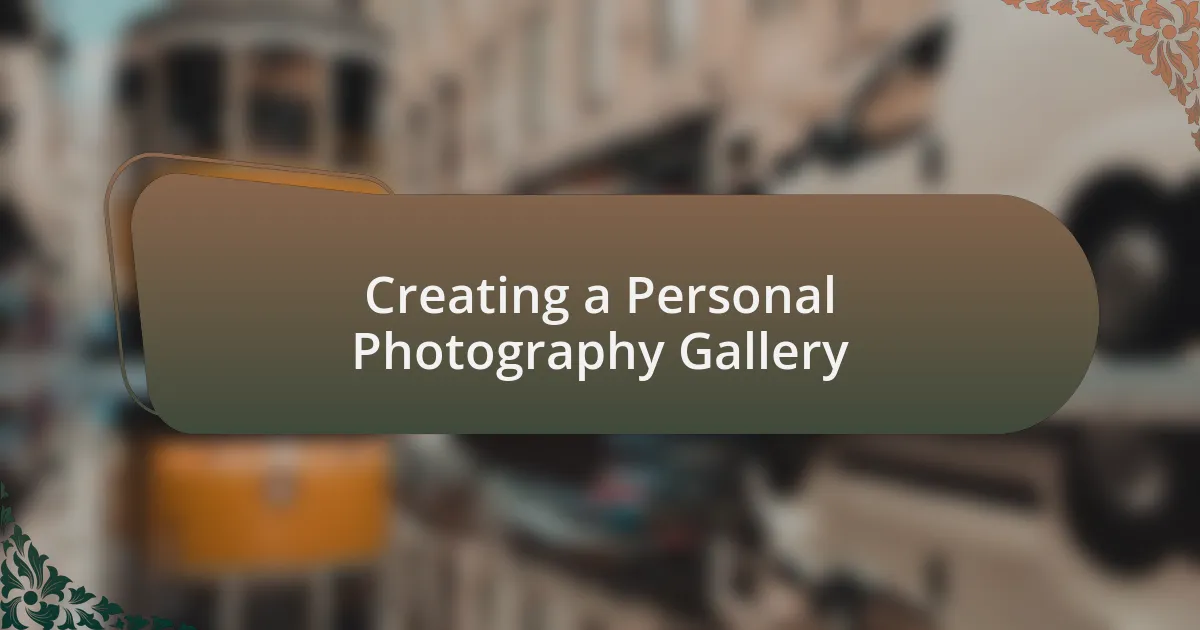
Creating a Personal Photography Gallery
Creating a personal photography gallery is about more than just showcasing images; it’s a reflection of your journey as a photographer. I recall the day I carefully selected images that meant the most to me, each one carefully telling its own story. I hung them on my bedroom wall, and every time I walked past, I felt a wave of nostalgia, almost like I was traveling back to those moments. Have you considered what your own gallery could reveal about you?
As I curated my collection, I focused on the emotional connection each photo held. One particular image stands out: I captured an elderly couple holding hands, their faces lit up with tenderness. Each time I view that photo, I can’t help but think about love, commitment, and the beauty of shared moments. How do we choose which memories to immortalize? For me, it’s the ones that resonate with the heart and spark conversations when others see them.
To enhance my gallery, I’ve started integrating a mix of mediums, adding handwritten notes beside each print. Reflecting on a particular shoot, I remember jotting down a few thoughts after meeting a captivating street performer. I remember how his laughter blended with the rhythm of the city, and those words next to his portrait add context and depth. Wouldn’t your collection be richer with that personal touch? It creates a narrative that invites viewers to step into your world and appreciate the stories behind each image.